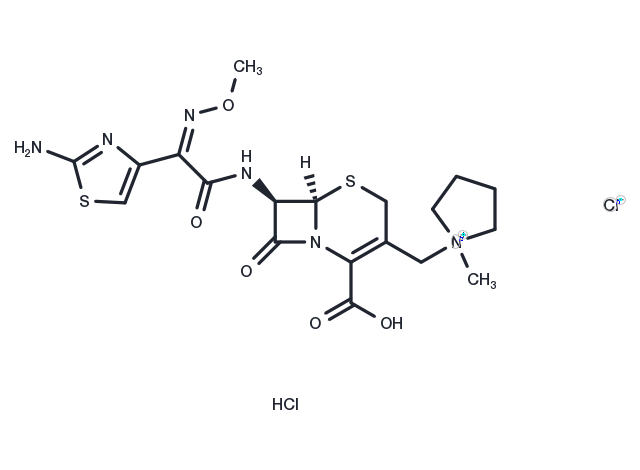Powder: -20°C for 3 years | In solvent: -80°C for 1 year


Cefepime dihydrochloride, a broad-spectrum fourth-generation cephalosporin, binds and inactivates penicillin-binding proteins (PBPs) located on the inner membrane of the bacterial cell wall.

| Pack Size | Availability | Price/USD | Quantity |
|---|---|---|---|
| 25 mg | Inquiry | $ 1,520.00 |
| Description | Cefepime dihydrochloride, a broad-spectrum fourth-generation cephalosporin, binds and inactivates penicillin-binding proteins (PBPs) located on the inner membrane of the bacterial cell wall. |
| Synonyms | Cefepime hydrochloride anhydrous, BMY-28142 dihydrochloride, Cepimax, Axepim, Cefepime HCl |
| Molecular Weight | 553.48 |
| Formula | C19H26Cl2N6O5S2 |
| CAS No. | 107648-80-6 |
Powder: -20°C for 3 years | In solvent: -80°C for 1 year
DMSO: Soluble
You can also refer to dose conversion for different animals. More
bottom
Please see Inhibitor Handling Instructions for more frequently ask questions. Topics include: how to prepare stock solutions, how to store products, and cautions on cell-based assays & animal experiments, etc.
Cefepime dihydrochloride 107648-80-6 Cefepime Dihydrochloride BMY28142 BMY28142 Dihydrochloride Cefepime hydrochloride anhydrous BMY-28142 BMY 28142 Dihydrochloride BMY-28142 Dihydrochloride Cefepime BMY-28142 dihydrochloride Cepimax Axepim Cefepime HCl BMY 28142 inhibitor inhibit
